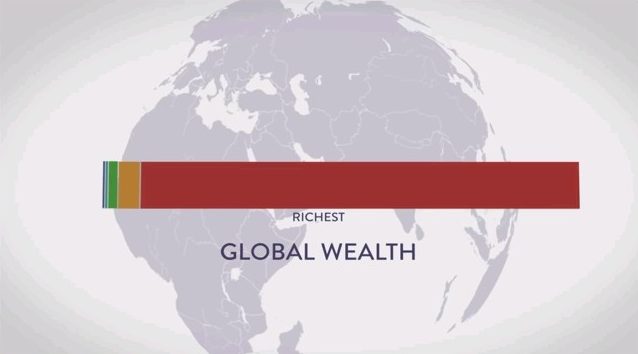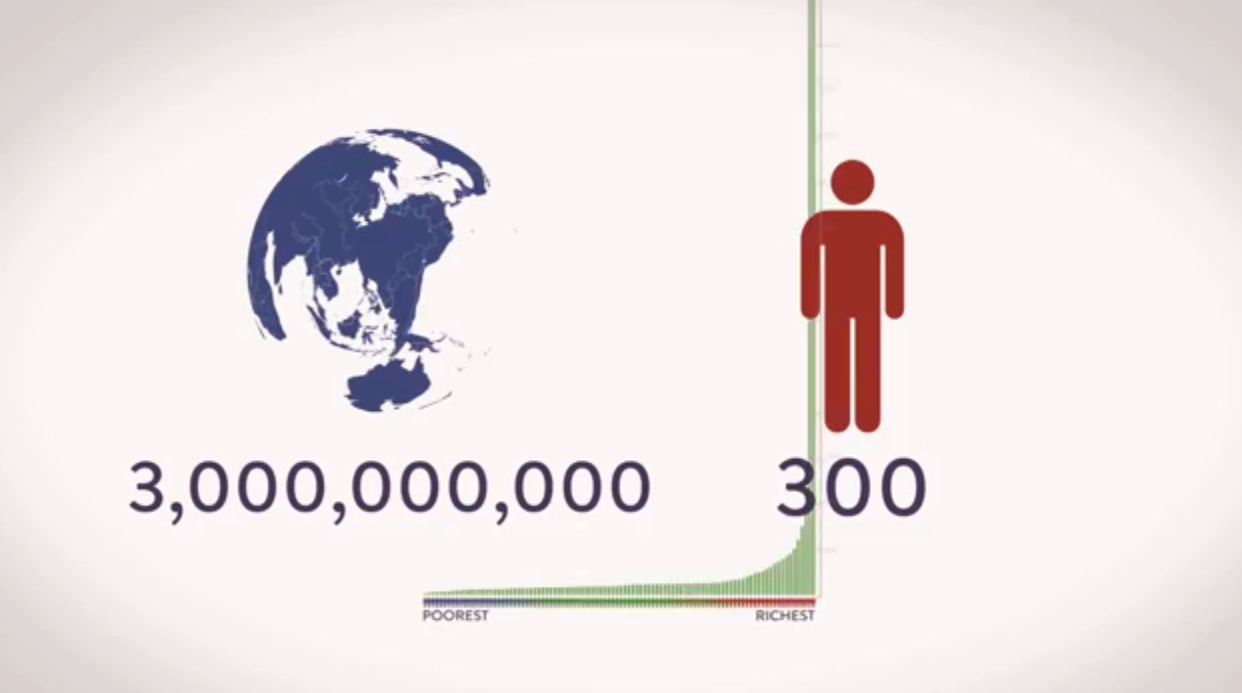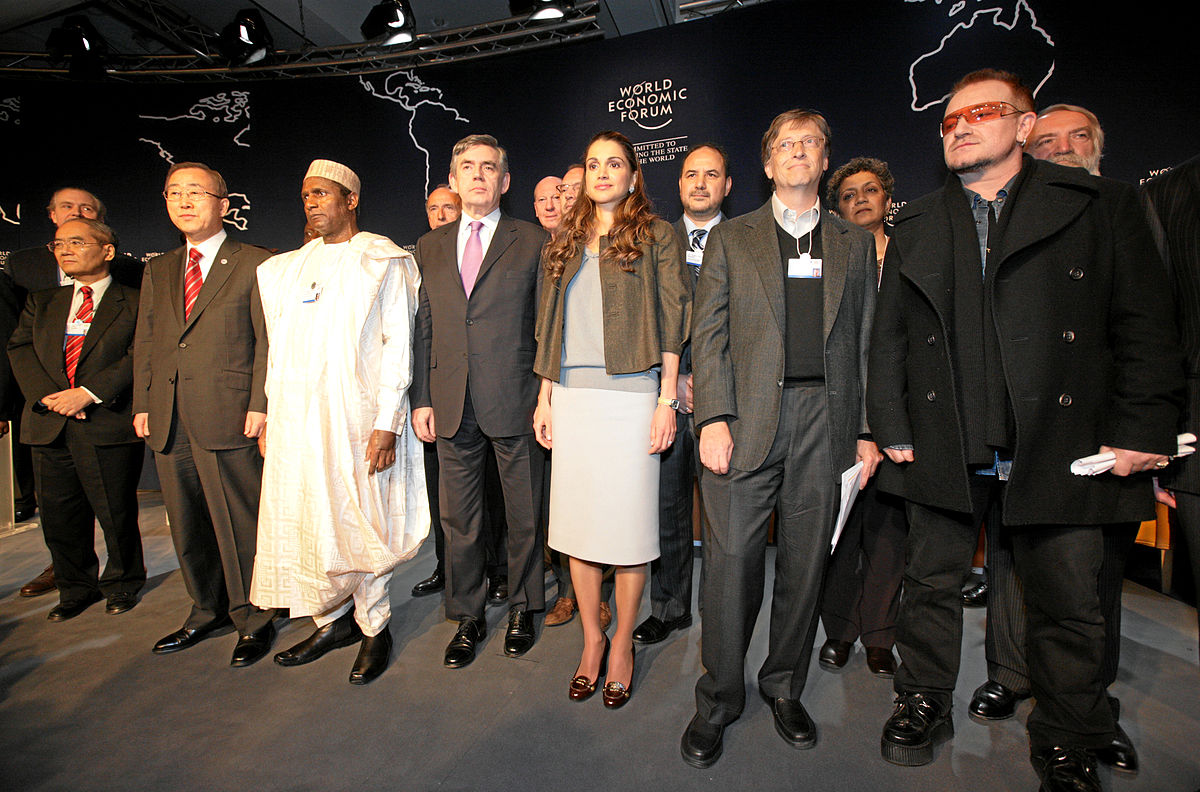
The idea of international development aid lies at the heart of a tremendously successful PR campaign. The narrative we have been sold claims that aid has been effective at reducing global poverty. Here I will argue that there are three problems with this narrative. First, poverty is not disappearing, despite what we have been told to believe. Second, aid disbursements from rich countries to poor countries are dwarfed by wealth flows that run in the other direction, to the point where poor countries are effectively developing rich countries. Third, and perhaps most critically, aid is not actually designed to reduce poverty, but operates as a tool that the elites of rich countries leverage to extract wealth, resources, and political compliance. By eliding these problems, the aid paradigm prevents development practitioners – and the public – from understanding the real causes of poverty, and therefore precludes meaningful solutions.
False accounting
The narrative that poverty rates are declining and that extreme poverty will soon be eradicated has a tremendous amount of institutional backing; it is supported by the world’s most powerful governments and promoted through the United Nations Millennium Campaign. But this narrative is misleading: poverty is not disappearing as quickly as they say. Thomas Pogge of Yale University has done a great deal of work to expose the false accounting that lies behind this narrative.
It was 1996, at a summit in Rome, when governments first pledged to use aid to halve the number of the world’s poor by 2015. Given the population at the time, the aim was to draw 836 million people out of poverty. But that goal has been surreptitiously shifted. In 2000, when the Millennium Development Goals (MDGs) were formally announced, they changed MDG-1 from halving the number of poor people to halving the proportion. This made the goal much easier to achieve because it could take advantage of a rapidly growing world population.
After the UN General Assembly adopted MDG-1, the goal was diluted two more times. First, they moved it from halving the proportion of the world’s population to halving the proportion of the population of only developing countries, to take advantage of an even faster-growing denominator. Second, they moved the starting point of analysis from 2000 back to 1990, thus retroactively claiming all of the poverty reduction accomplished by China during the 1990s. These changes mean that the original goal of drawing 836 million people out of poverty has been whittled down to 345 million. Having redefined the target, the UN can claim that poverty has been halved when in fact it has not.
On top of this, the International Poverty Line (IPL) has been revised downward a number of times over the past decades in order to serve the poverty-reduction narrative. The Millennium Campaign uses an IPL of $1.25 a day (PPP 2005). This figure, which is determined arbitrarily by the World Bank, has been carefully chosen to optimise the number of people that can be brought above it without much effort. Pogge has demonstrated that if we were to move the IPL just 2 cents upward, from $1.25 to $1.27, most of the poverty reduction gains vaunted by the Millennium Campaign would be wiped out.
Boosting people above the IPL does not mean boosting them out of poverty. $1.25 a day comes nowhere near to providing the adequate standard of living guaranteed by the Universal Declaration of Human Rights. In many countries, living at the IPL means living in destitution. World Bank economist Adam Wagstaff has demonstrated that in India 60% of children living at the IPL are undernourished. In Niger, infants born to families at the IPL face mortality rates of 160 in 1000, more than three times the world average. According to Peter Edward of Newcastle University, if we are to be serious about eliminating poverty the IPL needs to be set closer to $5 a day (after adjusting for inflation).
All of this raises questions about why world governments would be so eager to instil false confidence in a misleading poverty-reduction narrative.
Who is developing whom?
The second problem with the dominant narrative about aid is that it casts Western countries in the role of benevolent benefactors, giving generously of their wealth to poor countries in the Global South. In reality, however, exactly the opposite is true. The flow of aid from rich countries to poor countries pales in comparison to the flow of wealth that runs the other direction.
Developing countries receive about $136 billion in aid from donor countries each year. At the same time, however, they lose about $1 trillion each year through offshore capital flight, mostly in the form of tax avoidance by multinational corporations. That’s nearly 10 times the size of the aid budget.
Because rich countries include debt cancellation as aid, it is only fair that we include debt service payments as part of the equation as well. Today, poor countries pay about $600 billion to rich countries in debt service each year, much of it on the compound interest of loans accumulated by rulers long since deposed. This alone amounts to nearly five times the aid budget. Using this metric, economist Charles Abugre calculates that the net flow of aid from the West to the Global South over the period 2002 to 2007 was minus $2.8 trillion. And that does not include the capital flight that I mentioned above.
There are many other flows of wealth and income that are being siphoned from the Global South that we need to take into account. For example, Action Aid recently reported that multinational corporations extract about $138 billion from developing countries each year in tax holidays (which is different from tax avoidance). This figure alone outstrips the global aid budget.
For another example, we can look at the WTO’s agreement on intellectual property rights (Trips), which has armed corporations with unprecedented rent-seeking powers. As a result of Trips, developing countries have been forced to pay $60 billion annually – half the aid budget – in extra patent licensing fees, over and above those required by normal laws, for the use of technologies and pharmaceuticals that are often essential to development and public health.
We can see these figures as direct cash transfers from poor countries to rich countries. And this is to say nothing of other forms of extraction that are more difficult to quantify, such as land grabs.Fred Pearce shows that land exceeding the size of Western Europe has been grabbed from developing countries by corporations in the past decade alone. The US, UK, and China are leading this movement by snapping up agricultural land in regions where land tenure laws leave indigenous inhabitants vulnerable to dispossession.
The point is that aid does not exist in any meaningful sense. Poor countries are net creditors to rich countries. Aid serves as an illusion to mask this fact; it makes the takers seem like givers.
Aid as a tool of extraction
It is important to emphasise that this critique of aid differs from other popular critiques. The best-known of these, epitomised by Dambisa Moyo, argues that aid hinders development by creating dependencies. Moyo concludes that Western governments should cut off the flow of aid in order to force poor countries to solve their own development issues in the free market.
The problem with this perspective is that it assumes that poor countries are somehow naturally poor, as a consequence of their own internal problems. In this sense, it participates in the same fantasy as the aid paradigm itself. It sees aid as a gift that benevolent rich countries give out of a sense of compassion, in order to help poor countries up the development ladder. This story elides the extractive relationship between rich countries and poor countries. The poverty of the Global South is no more “natural” or “given” than is the wealth of the West. Rather, the two are intimately interconnected: the wealth of rich countries depends on the poverty of poor countries.
The problem is not that poor countries cannot manage to drag themselves up the development ladder, the problem is that they are actively prevented from doing so. Beginning in the early 1980s, Western governments and financial institutions like the World Bank and IMF changed their development policy from one that was basically Keynesian to one that remains devotedly neoliberal, requiring radical market deregulation, fiscal austerity, and privatisation in developing countries as a condition of receiving aid.
We were told that this neoliberal shock therapy – known as structural adjustment – would help stimulate the economies of poor countries. But exactly the opposite happened. Instead of helping poor countries develop, structural adjustment basically destroyed them. Cambridge economist Ha-Joon Chang has demonstrated that while developing countries enjoyed per capita income growth of more than 3% prior to the 1980s, structural adjustment cut it in half, down to 1.7%. When it was foisted on sub-Saharan Africa, per capita income began to decline at a rate of 0.7% a year, and average GNP shrank by around 10%. As a result, the number of Africans living in basic poverty nearly doubled. It would be hard to overstate the degree of human suffering that these figures represent.
Robert Pollin, an economist at the University of Massachusetts, estimates that developing countries have lost roughly $480 billion in potential GDP as a result of structural adjustment. Yet Western corporations have benefitted tremendously. It has forced open vast new consumer markets; it has made it easier to access cheap labour and raw materials; it has opened up avenues for capital flight and tax avoidance; it has created a lucrative market in foreign debt; and it has facilitated a massive transfer of public resources into private hands (the World Bank alone has privatised more than $2 trillion worth of assets in developing countries).
Poverty in the Global South is not just a static given; it is being actively created. And the striking thing is that these atrocities are being perpetrated under the cover of aid. In other words, not only does aid serve as a powerful rhetorical device that cloaks takers in the guise of givers, it also operates as a powerful tool in the global wealth extraction system.
The future of aid
If we want to be serious about eradicating poverty then we need to completely discard the aid paradigm. We have to recognise that poverty is the product of an economic system whose rules have been rigged to serve the interests of a few over those of the majority of humanity. As a result of this system, 1% of the world’s population has come to accumulate half of the world’s total wealth, and the richest 300 individuals lay claim to more than the poorest 3 billion.
We need rich countries to transfer money to poor countries, to be sure, and in much greater quantities than they presently do. But these transfers should not be considered charity; they should be considered a form of justice. Franz Fanon puts it best: “Colonialism and imperialism have not settled their debt to us once they have withdrawn from our territories. The wealth of the imperialist nations is also our wealth. Europe is literally the creation of the Third World. The riches which are choking it are those plundered from the underdeveloped peoples. So we will not accept aid for the underdeveloped countries as ‘charity’. Such aid must be considered the final stage of a dual consciousness – the consciousness of the colonised that it is their due, and the consciousness of the capitalist powers that effectively they must pay up.”
In addition to reparations, we need to dismantle the global wealth extraction system that continues to produce poverty. We need immediate cessation of capital flight and tax avoidance; we need total debt cancellation; we need a moratorium on land grabs; we need to democratise the institutions that control global economic policy, such as the World Bank, the IMF, and the WTO; we need to freeze all “free trade” agreements and renegotiate them under conditions of transparency and public debate; we need to roll back the patent laws under Trips.
Of course, rich country governments will never commit to these reforms. But that is because – behind the false rhetoric of aid – they have never been seriously interested in eradicating poverty.
This article originally appeared in Global Policy.









Leave a Comment